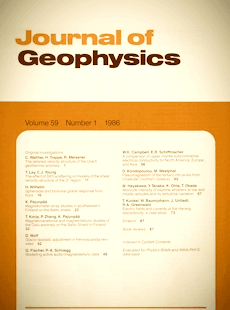Complete seismogram synthesis for transversely isotropic media
Article Sidebar

Vols. 1-18 (1924-1944), ISSN 0044-2801
Main Article Content
Abstract
The response at the surface of a layered transversely isotropic medium due to a buried dislocation source can be expressed by using propagator matrices and discrete wavenumber summation. These operations produce complete seismograms for earthquake or explosion sources which include all body- and surface-vave phases for this specialized anisotropic structure. In order to test the numerical procedures, synthetic seismograms at near distances for an isotropic model are compared with those generated by other methods. The agreement is found to be satisfactory in all cases. Comparisons of synthetic seismograms for anisotropic models having a small degree of anisotropy with similar but isotropic models, show that significant differences in travel times, amplitudes and wave forms can be caused by the anisotropy.
 ARK: https://n2t.net/ark:/88439/y066890
ARK: https://n2t.net/ark:/88439/y066890
Permalink: https://geophysicsjournal.com/article/226
Article Details
References
Anderson, D.L. (1961) Elastic wave propagation in layered anisotropic media. J. Geophys. Res. 66:2953-2963
Anderson, D.L., Dziewonski, A.M. (1982) Upper mantle anisotropy: evidence from free oscillations. Geophys. J. R. Astron. Soc. 69:383-404
Bamford, D., Crampin, S. (1977) Seismic anisotropy - the state of the art. Geophys. J. R. Astron. Soc. 49:1-8
Bezgodkov, V.A., Yegorkina, G.V. (1984) Experimental study of the anisotropy of longitudinal and transverse waves from local earthquake records. Geophys. J. R. Astron. Soc. 76:179-189
Booth, D.C., Crampin, S. (1983) The anisotropic reflectivity technique theory. Geophys. J. R. Astron. Soc. 72:755-766
Bouchon, M. (1981) A simple method to calculate Green's functions for elastic layered media. Bull. Seismol. Soc. Amer. 73:959-971
Cara, M., Nercessian, A., Nolet, G. (1980) New inferences from higher mode data in western Europe and northern Eurasia. Geophys. J. R. Astron. Soc. 61:459-478
Crampin, S. (1970) The dispersion of surface waves in multilayered anisotropic media. Geophys. J. R. Astron. Soc. 21:387-402
Cram pin, S. (1981) A review of wave motion in anisotropic and cracked elastic-media. Wave Motion 3, North-Holland Publishing Company, 343-391
Crampin, S., Taylor, D.B. (1971) The propagation of surface waves in anisotropic media. Geophys. J. R. Astron. Soc. 25:71-87
Dunkin, J.W. (1965) Computation of modal solutions in layered, elastic media at high frequencies. Bull. Seismol. Soc. Amer. 55:335-358
Fryer, G.J., Frazer, L.N. (1984) Seismic waves in stratified anisotropic media, elastic media at high frequencies. Geophys. J. R. Astron. Soc. 78:691-710
Gilbert, F., Backus, G.E. (1966) Propagator matrices in elastic wave and vibration problems. Geophysics 31:326-332
Harkrider, D.G. (1964) Surface waves in multi-layered elastic media I: Rayleigh and Love waves from buried sources in a multilayered half space. Bull. Seismol. Soc. Amer. 54:627-679
Harkrider, D.G. (1976) Potentials and displacements for two theoretical seismic sources. Geophys. J. R. Astron. Soc. 47:97-133
Harkrider, D.G., Anderson, D.L. (1962) Computation of surface wave dispersion for multilayered anisotropic media. Bull. Seismol. Soc. Amer. 52:321-332
Haskell, N.A. (1953) The dispersion of surface wave on multilayered media. Bull. Seismol. Soc. Amer. 43:17-34
Haskell, N.A. (1963) Radiation pattern of Rayleigh waves from a fault of arbitrary dip and direction of motion in a homogeneous medium. Bull. Seismol. Soc. Amer. 53:619-642
Herrmann, R.B. (1979) SH-wave generation by dislocation sources - A numerical study. Bull. Seismol. Soc. Amer. 69:1-15
Herrmann, R.B., Wang, C.Y. (1985) A comparison of synthetic seismograms. Bull. Seismol. Soc. Amer. 75:41-56
Hess, H.H. (1964) Seismic anisotropy of the uppermost mantle under oceans. Nature 203:629-631
Keith, C.M., Crampin, S. (1977) Seismic body waves in anisotropic media: synthetic seismograms. Geophys. J. R. Astron. Soc. 49:225-243
Kennett, B.L.N. (1974) Reflections, ray, and reverberations. Bull. Seismol. Soc. Amer. 64:1685-1696
Knopoff, L. (1964) A matrix method for elastic wave problems. Bull. Seismol. Soc. Amer. 54:431-438
Kogan, S.D. (1984) The azimuthal variation of teleseismic P-wave travel times. Geophys. J. R. Astron. Soc. 76:201-207
Love, A.E.H. (1927) The mathematical theory of elasticity. Cambridge Univ. Press, London and New York
Matuzawa, T. (1943) Elastische Wellen in einem anisotropen Medium. Bull. Earthq. Res. Inst. Tokyo 21:231-234
Peacock, S., Crampin, S. (1985) Shear-wave vibrator signals in transversely isotropic shale. Geophysics 52:1285-1293
Robertson, J.D., Corrigan, D. (1983) Radiation patterns of a shearwave vibrator in near-surface shale. Geophysics 48:19-26
Saito, M. (1967) Excitation of free oscillations and surface waves by a point source in a vertically heterogeneous Earth. J. Geophys. Res. 72:3689-3699
Schule, J.W., Knopoff, L. (1977) Shear-wave polarization anisotropy in the Pacific Basin. Geophys. J. R. Astron. Soc. 49:145-165
Takeuchi, H., Saito, M. (1972) Seismic surface waves. Methods in computational physics. Academic Press, New York, 11:217-295
Tanimoto, T., Anderson, D.L. (1984) Mapping convection in the mantle. Geophys. Res. Lett. 11:287-290
Wang, C.Y. (1981) Wave theory for seismogram synthesis. Ph.D. Dissertation, Saint Louis University, St. Louis, Missouri USA
Wang, C.Y., Herrmann, R.B. (1980) A numerical study of P-, SV-, and SH-wave generation in a plane layered medium. Bull. Seismol. Soc. Amer. 70:1015-1036
Yao, Z.X., Harkrider, D.G. (1983) A generalized reflection-transmission coefficient matrix and discrete wavenumber method for synthetic seismograms. Bull. Seismol. Soc. Amer. 73:1685-1699
Yu, G.K., Mitchell, B.J. (1979) Regionalized shear velocity models of the Pacific upper mantle from observed Love and Rayleigh wave dispersion. Geophys. J. R. Astron. Soc. 57:311-341











